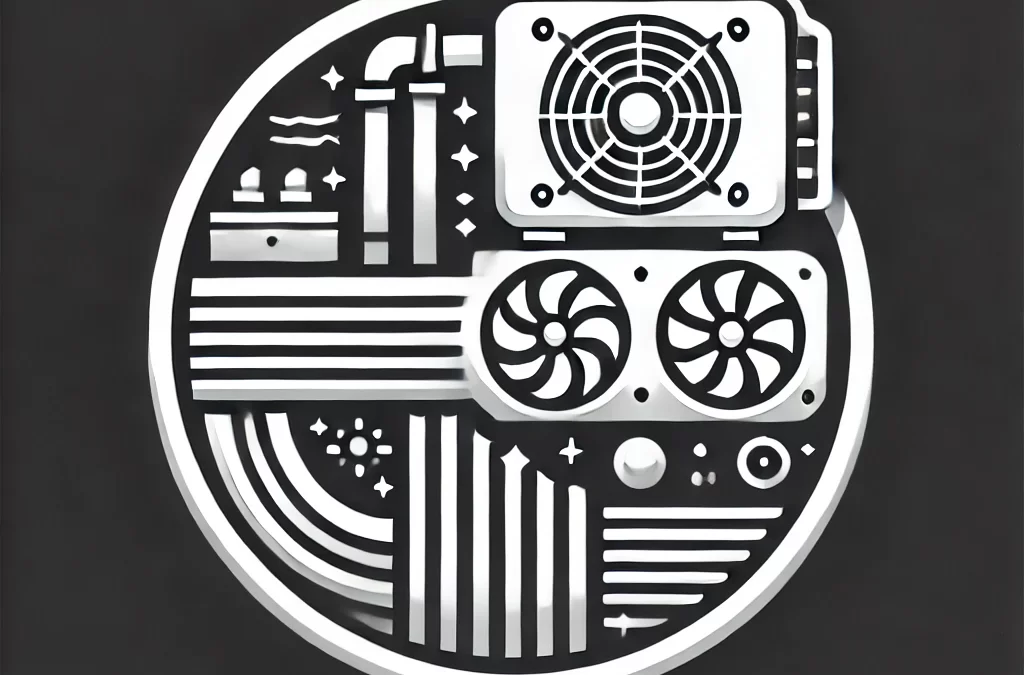10 Proven Strategies to Streamline Your HVAC Business Operations
10 Essential Strategies to Streamline Your HVAC Business Operations
Expanding your HVAC business can feel overwhelming, but it doesn’t have to be. Many companies struggle with growth, while others thrive by using effective strategies. The difference lies in knowing the right moves, including smart HVAC marketing strategies, to develop and implement an effective HVAC marketing idea.
This post dives into proven HVAC business expansion strategies that can elevate your success. We’ll cover key techniques like diversifying services, enhancing customer relationships, and leveraging technology. Each strategy is designed to boost your market presence and profitability. Whether you’re a seasoned player or just starting out, these insights will help you navigate the competitive landscape and achieve sustainable growth.
Essential Takeaways for Streamlining HVAC Business Operations
Create a Detailed Business Plan: Outline your goals, target market, and expansion strategies to effectively guide your HVAC business growth.
Streamline Systems and processes: Develop efficient systems that can handle increased demand and ensure smooth operations as you expand.
Stay Informed About Competitors: Regularly analyze your competitors to identify their strengths and weaknesses, which will allow you to differentiate your services.
Enhance Customer Communication: Use clear and consistent communication channels to keep customers informed and engaged, which builds loyalty.
Encourage Internal Feedback: Create an environment where employees feel comfortable sharing ideas and concerns, leading to continuous improvement.
Promote a Positive Company Culture: Foster a supportive workplace that values transparency and teamwork, helping retain talent during expansion.
Create a Business Plan
Set Clear Goals 
Successful HVAC businesses start with clear goals. These specific, measurable objectives guide expansion efforts. Business owners should define what success looks like for their company. This could mean increasing revenue by a certain percentage or expanding to new locations.
Aligning team efforts with the overall vision is crucial. Each member must understand their role in reaching these goals. Regular meetings can help keep everyone on track. Establishing timelines for achieving goals maintains accountability. Tracking progress ensures that the business stays focused on its objectives.
Identify Target Market
Understanding the target market is essential for growth. Researching demographics helps identify potential customers’ needs and preferences. HVAC entrepreneurs can use surveys and customer feedback for this purpose.
Segmenting the market allows businesses to tailor marketing strategies effectively. Different customer groups may respond better to specific messages or services. For example, residential clients might prefer energy-efficient solutions, while commercial clients may focus on cost-effectiveness.
Analyzing trends in the HVAC industry reveals emerging markets and opportunities. Keeping up with technological advancements can provide a competitive edge. For instance, smart home technology is becoming increasingly popular. Businesses that adapt to these changes can attract more customers.
Financial Planning
Financial planning is a cornerstone of any successful HVAC business plan. Create a detailed budget that outlines expected expenses and revenues during expansion. This budget should include costs like equipment purchases, hiring staff, and marketing efforts.
Exploring various funding options supports growth initiatives. Business owners can consider loans, investors, or even grants tailored for small businesses. Each option has its pros and cons, so careful evaluation is necessary.
Monitoring cash flow regularly ensures financial stability during expansion. Understanding when money comes in and goes out helps avoid unexpected shortfalls. A positive cash flow allows HVAC business owners to invest in new opportunities as they arise.
Develop Systems and Processes
Document Procedures
Developing standard operating procedures (SOPs) is crucial for any HVAC business. SOPs ensure consistency across all functions. They guide employees in performing tasks correctly, which enhances the overall quality of service.
Documentation should be updated regularly to stay relevant. Changes in processes or best practices should be reflected promptly, helping maintain efficiency. Staff training on documented procedures is essential. Proper training reduces errors and boosts confidence among employees.
Use Automation Tools
Implementing software solutions can significantly improve operational efficiency. Automation tools reduce the time spent on repetitive tasks. For instance, scheduling software helps optimize service appointments, minimizing downtime and maximizing productivity.
Marketing automation also plays a vital role in customer engagement. HVAC companies can streamline outreach efforts using these tools. Automated emails and follow-ups keep customers informed and engaged with minimal effort.
Regularly Review Systems
Conducting periodic assessments of operational systems is necessary to identify areas for improvement. Regular reviews help businesses stay competitive in the HVAC industry. Feedback from employees provides valuable insights into system effectiveness.
Fostering a culture of continuous improvement is essential. Employees often have firsthand knowledge of challenges faced daily. Adjusting systems based on performance metrics can lead to enhanced productivity. Tracking key performance indicators (KPIs) allows businesses to measure success accurately.
Implement New Systems
Checklist for New Systems
A comprehensive checklist is vital for evaluating new systems before implementation. It should cover all aspects of the system, including functionality, cost, and compatibility with existing processes. Involving team members in this process ensures that various perspectives are considered. Each member may identify unique challenges or benefits based on their experience.
Testing new systems in a controlled environment is crucial. Doing so helps identify potential issues before full rollout. This step can save time and resources in the long run. It also allows for adjustments to be made based on real-world performance.
Staff Training
Investing in ongoing training programs keeps employees updated on industry standards and technologies. Training ensures that staff members understand how to use new systems effectively. Regular workshops or online courses can be beneficial.
Encouraging cross-training develops versatile team members who can handle multiple roles. This flexibility can improve overall efficiency within the HVAC company. Employees who understand various functions can fill in gaps during busy periods or staff shortages.
Evaluating training effectiveness through assessments and feedback is essential. This evaluation ensures knowledge retention and identifies areas needing improvement. Regular check-ins help reinforce learning and keep skills sharp.
Monitor Performance
Establishing key performance indicators (KPIs) is critical to measure success across various business areas. KPIs can include customer satisfaction, response times, and installation efficiency. Monitoring these metrics provides valuable insights into business operations.
Using performance data allows for informed decisions regarding strategy adjustments. If certain areas underperform, it may indicate the need for additional training or system enhancements. Recognizing patterns in performance metrics helps anticipate challenges and opportunities.
For example, if a spike in service calls occurs during the summer months, preparation becomes necessary. Adjustments to staffing levels or inventory management may be required to meet demand.
Focus on Competitors
Analyze Competitor Strategies
Conducting a competitive analysis is essential. This process helps identify the strengths and weaknesses of rival businesses. Understanding what competitors do well can inform your own strategies. It also highlights areas where they may fall short.
Identifying unique selling propositions (USPs) is crucial. These USPs differentiate your HVAC services from others in the market. For example, if a competitor offers fast service, you might focus on energy-efficient solutions. Staying informed about industry trends keeps you aware of competitor innovations. Regularly reviewing their marketing campaigns and customer feedback provides valuable insights.
Differentiate Your Services
Highlighting unique features of your HVAC services attracts customers. For instance, if you use eco-friendly materials, communicate clearly in your messaging. Developing niche offerings can cater to specific customer needs. Offering specialized services like smart home installations can set you apart.
Communicating these differentiators effectively enhances brand recognition. Use precise language in marketing materials. Visuals can help showcase what makes your services stand out. Engaging content on social media can also attract attention.
Competitive Pricing
Researching market pricing ensures your rates remain competitive yet profitable. Knowing what others charge helps you position yourself correctly. Consider offering tiered pricing options to appeal to a broader range of customers. This strategy allows clients to choose based on their budget and needs.
Regularly assessing pricing strategies is vital for adaptation. Market conditions change frequently, as do customer expectations. Gathering feedback from clients can guide necessary adjustments to your pricing model.
Improve Customer Communication
Streamline Customer Support
Many HVAC business owners struggle with customer inquiries. Implementing a ticketing system can help manage these requests efficiently. This system organizes inquiries and tracks their status. It ensures that no request goes unanswered.
Training support staff is crucial. Staff should learn to resolve issues quickly. This training enhances customer satisfaction and builds trust. Customers appreciate prompt responses and solutions. Utilizing self-service options, such as FAQs, empowers customers. They can find answers independently, reducing the workload on support staff.
Use CRM Software
Adopting customer relationship management (CRM) software is a smart HVAC marketing strategy. CRM systems track interactions with customers and manage leads effectively. This software allows businesses to segment customer data for targeted communication.
Personalized marketing efforts are more effective. Businesses can tailor messages based on customer preferences and behavior. Analyzing CRM data helps identify trends in customer engagement. This analysis improves strategies and fosters better relationships with ideal HVAC customers.
Regular Feedback Collection
Establishing routine methods for gathering feedback is essential. Surveys and interviews provide valuable insights into customer satisfaction, but many HVAC business owners overlook the importance of regular feedback collection.
Acting on feedback shows a commitment to improvement. Customers feel valued when their opinions matter, which creates loyalty and encourages repeat business. Employees also benefit from feedback mechanisms. Their insights can lead to operational improvements.
Feedback helps identify areas needing attention. Acting promptly is vital, whether it’s service quality or communication methods. This approach aligns with successful HVAC company practices.
Enhance Internal Communication
Team Meetings
Regular team meetings are essential for any HVAC business. They provide a platform to discuss progress and challenges. Scheduling these meetings weekly or bi-weekly keeps everyone aligned. Open dialogue during these discussions fosters collaboration. Team members can share ideas freely, leading to better problem-solving.
Setting clear agendas is crucial. Agendas ensure that meetings remain focused and productive. Each meeting should have specific goals. This allows teams to track progress effectively. Following up on previous discussions also enhances accountability.
Internal Messaging Tools
Implementing internal messaging tools can significantly increase communication speed. These platforms allow quick exchanges of information among team members, facilitate project updates, and enhance collaboration. Encouraging the use of messaging tools builds a more connected team environment.
Monitoring the usage of these tools is important. It helps identify any communication gaps or issues early on. Addressing these concerns promptly can prevent misunderstandings later. Regular training on effective use can maximize their benefits.
Clear Role Definitions
Defining specific roles and responsibilities is vital for clarity within the team. Each member should know their tasks and how they contribute to the overall objectives. This reduces confusion and increases efficiency in operations.
Communicating expectations empowers employees. When individuals understand what is expected, they take ownership of their work. Regularly reviewing role definitions helps adapt to changing business needs. As the HVAC business grows, roles may need adjustments to meet new demands.
Embrace Feedback
Collect Internal Feedback
Employees play a crucial role in the HVAC business. Their insights can improve workplace processes and culture. Encourage them to share thoughts through open discussions. Anonymous surveys can be a valuable tool. They allow for honest feedback without fear of repercussions.
Actively responding to this feedback is essential. It shows employees that their opinions matter, fostering a culture of trust and continuous improvement. When employees feel heard, they are more engaged, which often leads to better service delivery.
Gather Customer Feedback
Customers provide critical insights into your services. Creating channels for them to share feedback is vital. This can include online surveys, comment cards, or direct communication after service calls. Use this information to identify strengths and weaknesses in service delivery.
Sharing customer feedback with the team can drive improvements. Highlight positive remarks to boost morale. Discuss areas needing attention during team meetings. This helps everyone understand customer expectations better.
Implement Feedback Changes
Prioritizing actionable feedback is key to effective change. Start by analyzing the collected feedback and identifying common themes. Develop a clear plan for implementing necessary changes based on this analysis.
Communicate these changes to both staff and customers. Transparency builds trust and shows commitment to improvement. For example, if customers express concerns about response times, implement new scheduling practices and inform them of the changes.
Monitoring the impact of these changes is equally important. Assess their effectiveness through follow-up surveys or performance metrics. Be prepared to make further adjustments as needed.
Foster Transparency
Open Communication Channels
Establishing multiple avenues for communication is crucial. Management should create platforms where employees can share ideas and concerns. This could include regular meetings, suggestion boxes, or digital forums. Employees need to feel comfortable voicing their opinions. A culture that encourages open dialogue helps identify issues early. Regularly reviewing these communication channels ensures they remain effective. Adjustments may be necessary as the team evolves.
Share Business Goals
Communicating the company’s goals is essential for alignment. All employees should understand the objectives of the business. This clarity helps everyone work towards a common purpose. Involving team members in setting these goals fosters a sense of ownership. When employees contribute to goal-setting, they feel more invested in outcomes. Regular updates on progress keep motivation high. Sharing successes and challenges helps maintain focus.
Regular Updates
Providing consistent updates is key to transparency within the organization. Businesses should share information about performance and strategic initiatives regularly. Newsletters or team meetings can serve as effective tools for this purpose. Keeping everyone informed engages employees and builds trust. Feedback on these updates is valuable for improving future communications. It allows management to adapt based on employee responses.
Transparency in an HVAC business creates a stronger team environment. The previous section emphasized the importance of embracing feedback. By fostering transparency, businesses can enhance this feedback loop further. Employees are more likely to share insights when they feel included and informed.
Maintain Positive Culture
Encourage Team Positivity
A positive workplace culture is vital for any HVAC business. Team-building activities can strengthen relationships and improve communication. Regular gatherings help employees bond and build trust. Recognizing individual contributions also boosts morale. Leaders should model positive behavior to inspire their teams. They set the tone for the workplace. Addressing negativity quickly prevents it from spreading. This action keeps morale high and maintains productivity.
Team members thrive in an environment where they feel valued. Encouraging open dialogue allows employees to share concerns. When issues arise, leaders should respond with empathy. This approach fosters a supportive atmosphere. A positive mindset within the team enhances collaboration and innovation.
Recognize Achievements
Recognizing achievements plays a crucial role in motivation. Celebrating both individual and team accomplishments helps boost morale. Implementing a recognition program can highlight outstanding contributions regularly. This program might include awards, shout-outs during meetings, or small incentives.
Sharing success stories within the organization inspires others. It shows what is possible when hard work pays off. When recognized, employees feel proud of their contributions, and this acknowledgment encourages them to continue striving for excellence.
Recognition can also take place through informal channels. Simple thank-you notes or verbal praise can significantly impact employee satisfaction. Consistent recognition builds a culture of appreciation that fosters loyalty.
Support Work-Life Balance
Supporting work-life balance is essential for employee well-being. Flexible work arrangements help employees manage personal and professional commitments effectively. Options like remote work or adjusted hours cater to diverse needs.
Promoting wellness initiatives can enhance mental and physical health. Programs may include fitness challenges, counseling services, or workshops on stress management. These initiatives show employees that their well-being matters.
Regular assessments of workload distribution prevent burnout. Leaders should ensure that tasks are manageable for all team members. Open communication about workloads allows for adjustments when needed. A balanced approach keeps productivity high while maintaining employee satisfaction.
Maintaining a positive culture within an HVAC business is key to its success. Encouraging positivity, recognizing achievements, and supporting work-life balance create a thriving environment. These strategies not only improve employee morale but also drive business growth.
Closing Thoughts
Expanding your HVAC business isn’t just about growth but smart strategies that elevate your game. You’ve learned how to craft a solid business plan, streamline processes, and monitor your competition. Improving communication, embracing feedback, and fostering a positive culture are essential to creating a thriving environment.
Now, it’s time to take action. Implement these strategies today and watch your business soar. Don’t wait for opportunities—create them. The HVAC market is competitive, but with the right approach, you can stand out. Dive in and make your mark!
Frequently Asked Questions
What are effective strategies for HVAC business expansion?
Effective strategies include creating a solid business plan, developing efficient systems, focusing on competitors, and enhancing customer communication. These steps help streamline operations and improve market presence.
How can I create a business plan for my HVAC company?
Start by defining your goals, target audience, and market analysis. Include financial projections and marketing strategies. A clear plan guides decision-making and attracts investors.
Why is developing systems and processes important?
Developing systems ensures consistency and efficiency in operations. It helps standardize tasks, reduces errors, and improves service quality, increasing customer satisfaction.
How can I improve customer communication in my HVAC business?
Utilize multiple channels like email, phone, and social media to engage customers. Regular updates, personalized messages, and prompt responses enhance relationships and build trust.
What role does competitor analysis play in the expansion?
Analyzing competitors provides insights into market trends and consumer preferences. Understanding their strengths and weaknesses allows you to identify opportunities for differentiation and growth.
How can I embrace feedback from customers?
Encourage reviews through surveys or direct communication. Analyze feedback to identify areas for improvement. Implementing changes based on customer input fosters loyalty and enhances service quality.
Why is maintaining a positive culture crucial for expansion?
A positive company culture boosts employee morale and productivity. Happy employees provide better service, which leads to customer satisfaction and ultimately drives business growth.

